Table of Contents
Introduction
The OODA loop is a decision-making framework used to analyze situations and make rapid decisions. It stands for Observe, Orient, Decide, and Act.
- Observe: See the whole picture before making your move.
- Orient: Align your perception with reality and context.
- Decide: Choose the best course based on what you know.
- Act: Execute quickly and adapt as new information flows in.
Colonel John Boyd originally developed the framework, which is used in various fields, including the military, business, and even personal decision-making.

The model emphasizes improving reaction time and adaptability in dynamic situations. It encourages cycling through its four stages to make faster, more effective decisions in the face of uncertainty or competition.
In this blog, we will delve into the origin of the OODA Loop, explain the model in detail, highlight its importance, outline practical steps to implement it, and explore its diverse applications along with key takeaways for leveraging this powerful framework in real life.
The OODA Loop
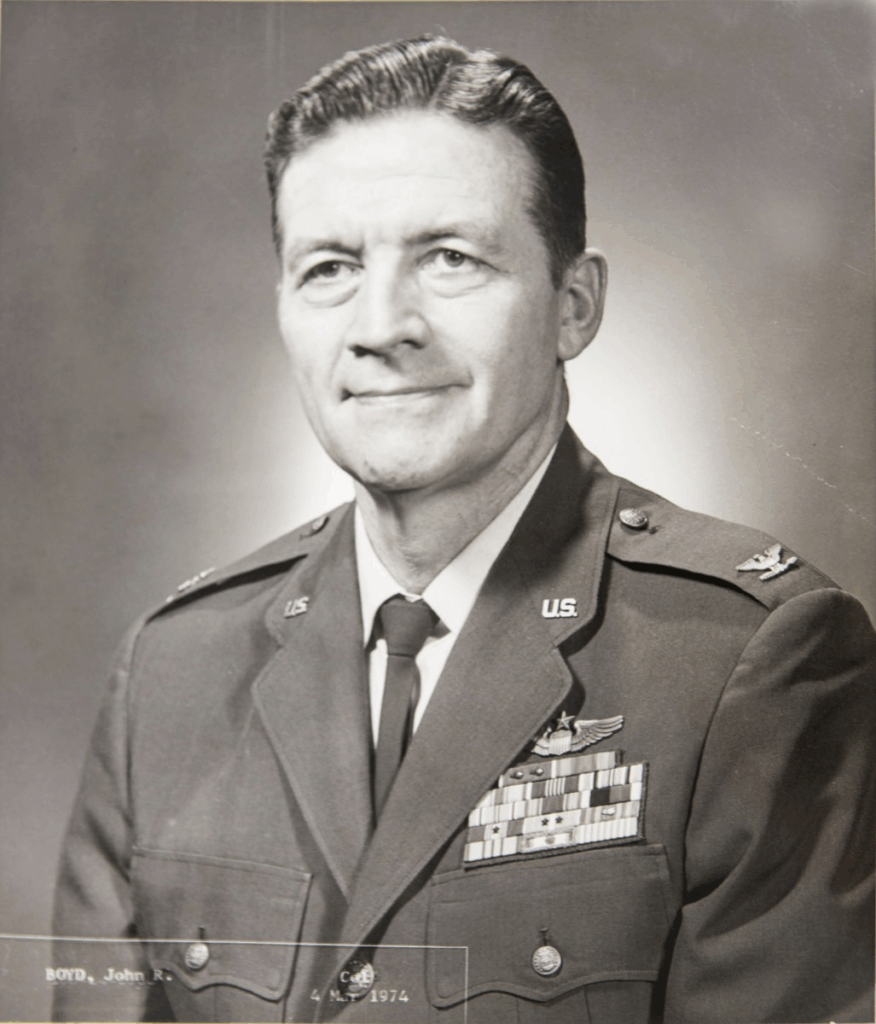
Colonel John Boyd, U.S. Air Force, developed an iterative feedback model, which is now known as the OODA loop, after his experiences dogfighting in the Korean War.
- Since then, it has become one of the most popular decision-making frameworks in the world, both in professional Western militaries and beyond.
- Businesses such as Dell and Scotts Miracle-Gro have implemented OODA-like processes, and in various sports, Boyd’s OODA loop has been studied as a means to improve athlete game speed

Boyd’s OODA Loop is often depicted as a simple four-stage linear cycle. The cycle begins with an observation, which leads a participant to orient on possible options, then decide on an appropriate course of action, and finally act on that decision.
At that point, the results are observed, and the cycle begins again. In this version, success is a function of cycling through the OODA Loop faster than one’s opponent.
The Four Phases of the OODA Loop
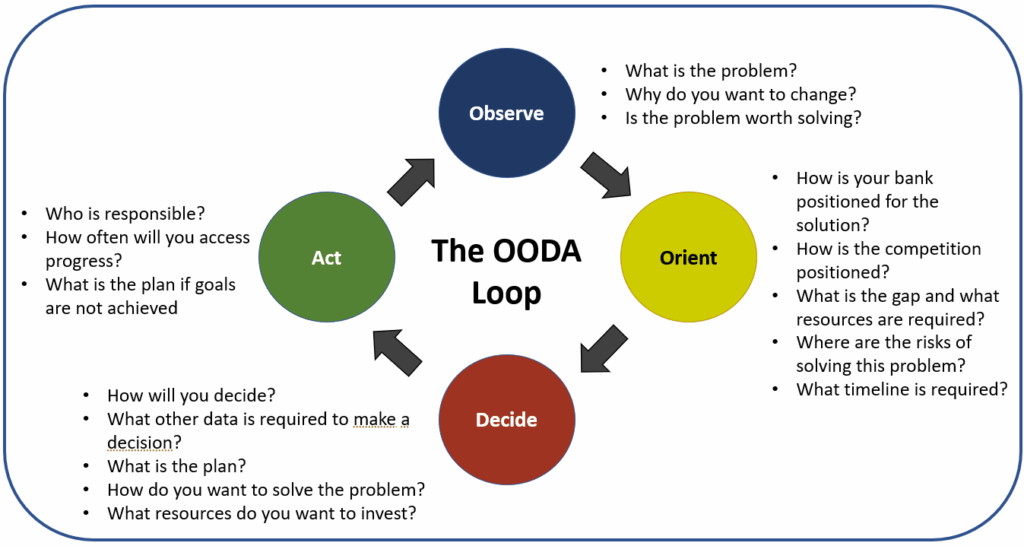
The OODA Loop model is a powerful mental framework that helps individuals and organizations navigate complex and rapidly changing situations.
“The way to win in a battle according to military science is to know the rhythms of the specific opponents, and use rhythms that your opponents do not expect.” —Miyamoto Musashi
Developed initially for military use, it has become a trusted strategy in competitive business environments, crisis response, leadership, and even personal development.
Observe
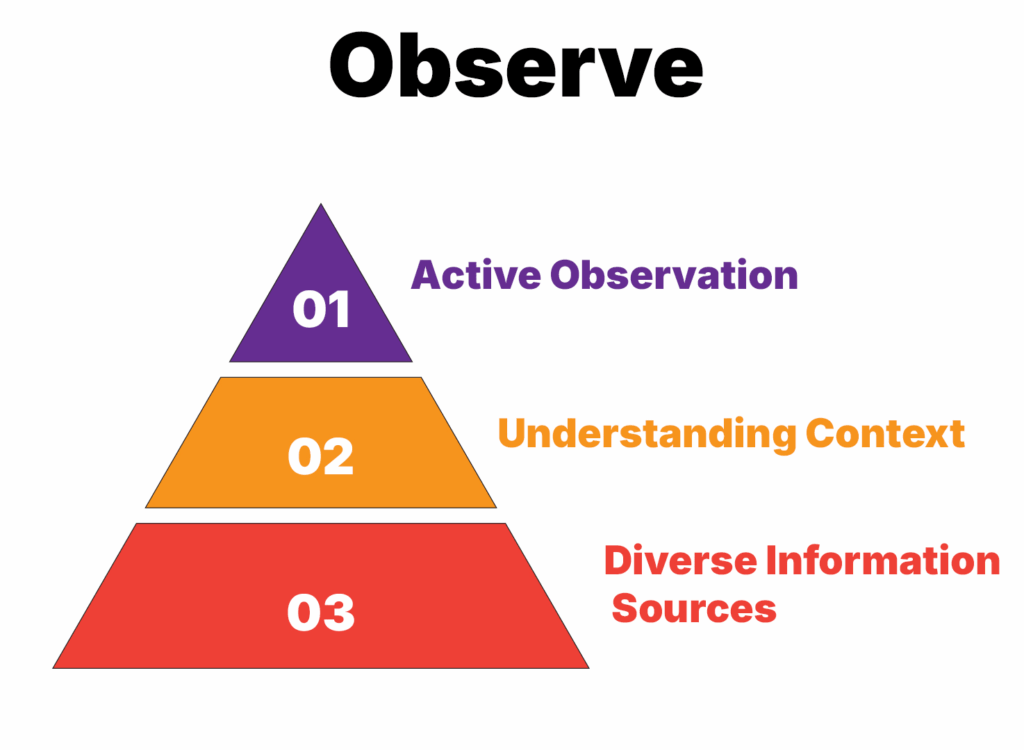
The first step in the OODA Loop is Observe. This phase involves gathering accurate and up-to-date information about the environment, the competition, and any relevant internal or external factors.
- Active Observation: Observation goes beyond passive noticing—it requires active data collection and situational awareness.
- Understanding Context: You need to monitor not just what is happening, but also why it is happening. This includes identifying patterns, anomalies, threats, and opportunities.
- Diverse Information Sources: The information collected can come from a variety of sources, including real-time analytics, customer feedback, competitor behavior, market trends, and internal organizational performance metrics.
Orient
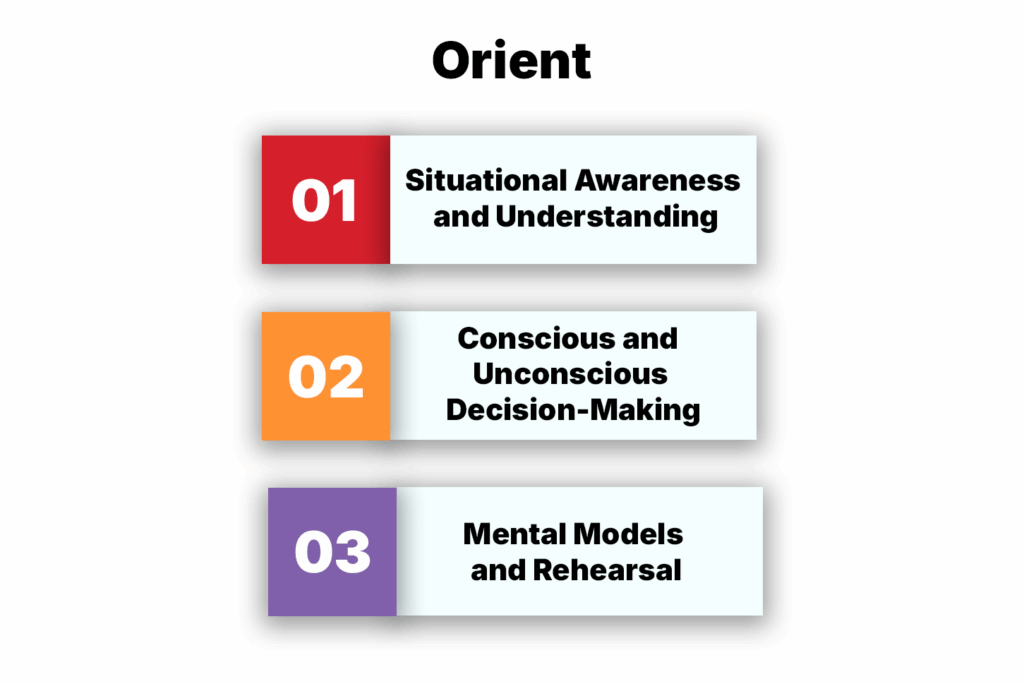
The Orient phase is perhaps the most intellectually demanding part of the loop. This stage is about context—placing the raw information within a broader framework of knowledge, experience, culture, and situational awareness.
- Situational Awareness and Understanding: This step demands a high level of awareness to consciously interpret the environment and assess what actions should be taken.
- Conscious and Unconscious Decision-Making: Some decisions are instinctive, while others require deeper consideration. The Orient phase involves evaluating both types to understand the rationale behind choices.
- Mental Models and Rehearsal: On an individual level, mental models and mental rehearsal drills help structure information into meaningful narratives that guide judgment.
This step shapes your worldview and determines how effectively you can understand and respond to your environment. It’s a filtering process that helps you prioritize what truly matters from the noise.
Decide
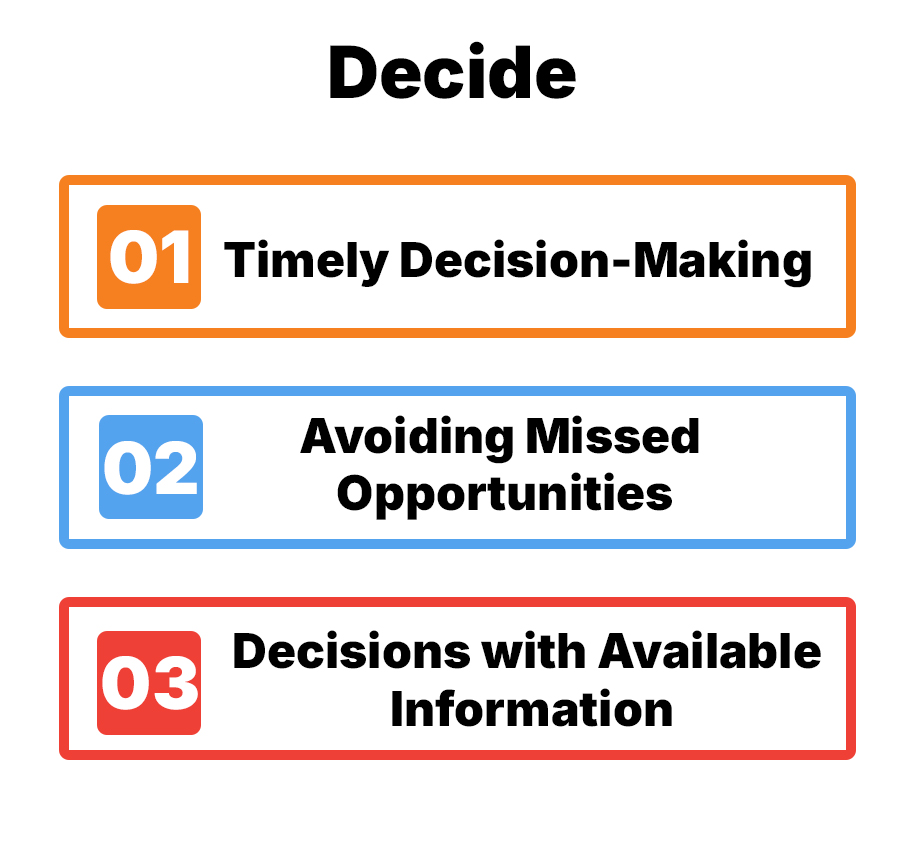
Once you’ve oriented yourself within the context, the next step is to decide. In this phase, you choose a specific course of action based on your analysis.
- Timely Decision-Making: Unlike more rigid decision-making models that emphasize exhaustive analysis and extended deliberation, the OODA Loop encourages swift decision-making to stay ahead in dynamic environments.
- Avoiding Missed Opportunities: In fast-paced environments, waiting for perfect information or absolute certainty can lead to missed opportunities. The OODA Loop emphasizes taking action rather than waiting for ideal conditions.
- Decisions with Available Information: The focus of the OODA Loop is on making the best decision possible with the information currently available, ensuring timely responses and flexibility in uncertain situations.
This decision could range from launching a product, adjusting a marketing strategy, responding to a competitor’s move, or taking corrective action in a crisis.
Act
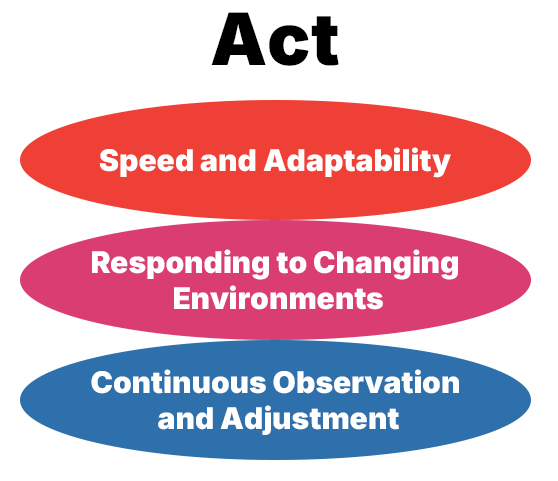
The final phase is Act—executing the decision you’ve made. This step tests your chosen strategy in the real world. It’s not just about taking action, but taking effective action that aligns with your analysis and objectives.
- Speed and Adaptability: Speed is essential, but adaptability is equally important. The ability to adjust quickly to changing circumstances is crucial for sustained success.
- Responding to Changing Environments: The environment will continue to evolve even after action is taken. Your success depends on how quickly and effectively you respond to these ongoing changes.
- Continuous Observation and Adjustment: After taking action, the observation phase restarts. It’s essential to immediately assess the outcomes and their impact, which sets the stage for the next cycle of the OODA Loop.
Each action produces results that feed into the next round of observation and orientation, allowing you to adjust and optimize your approach continuously.
Benefits of OODA Loop
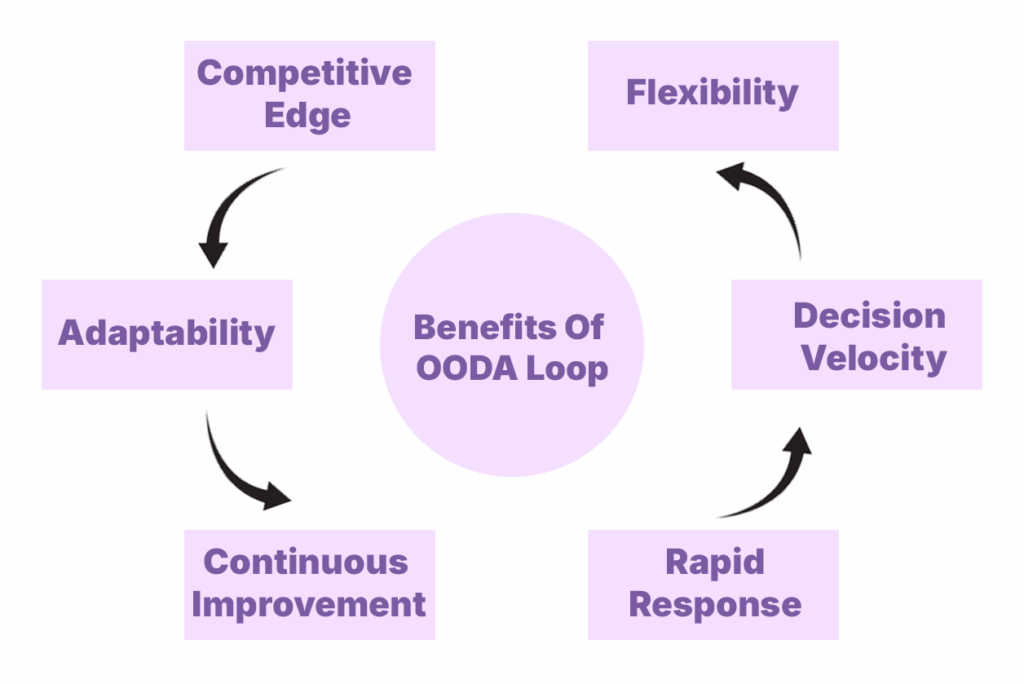
- Flexibility: Promotes agility and quick adaptation, allowing individuals and organizations to adjust to shifting circumstances effectively. This ensures smoother transitions and resilience when facing unexpected challenges.
- Decision Velocity: Speeds up the decision-making process, providing a crucial edge in fast-moving and competitive environments. Faster decisions enable quicker execution, helping seize fleeting opportunities.
- Continuous Improvement: Encourages ongoing learning and refinement through each cycle, enhancing strategies and execution over time. Each iteration sharpens performance and reduces the likelihood of repeated mistakes.
- Rapid Response: Streamlines information processing, enabling swift assessment and action in complex or high-pressure situations. This responsiveness minimizes delays and improves the quality of timely interventions.
- Adaptability: Offers multiple paths for adjustment, strengthening organizational resilience in dynamic or uncertain markets. It supports innovation by making room for alternative strategies and solutions.
- Competitive Edge: Helps organizations consistently outmaneuver competitors by accelerating the decision-to-action timeline, securing a strategic advantage. This proactive stance makes it harder for rivals to predict or counter your moves.
Steps to Implement OODA Loop
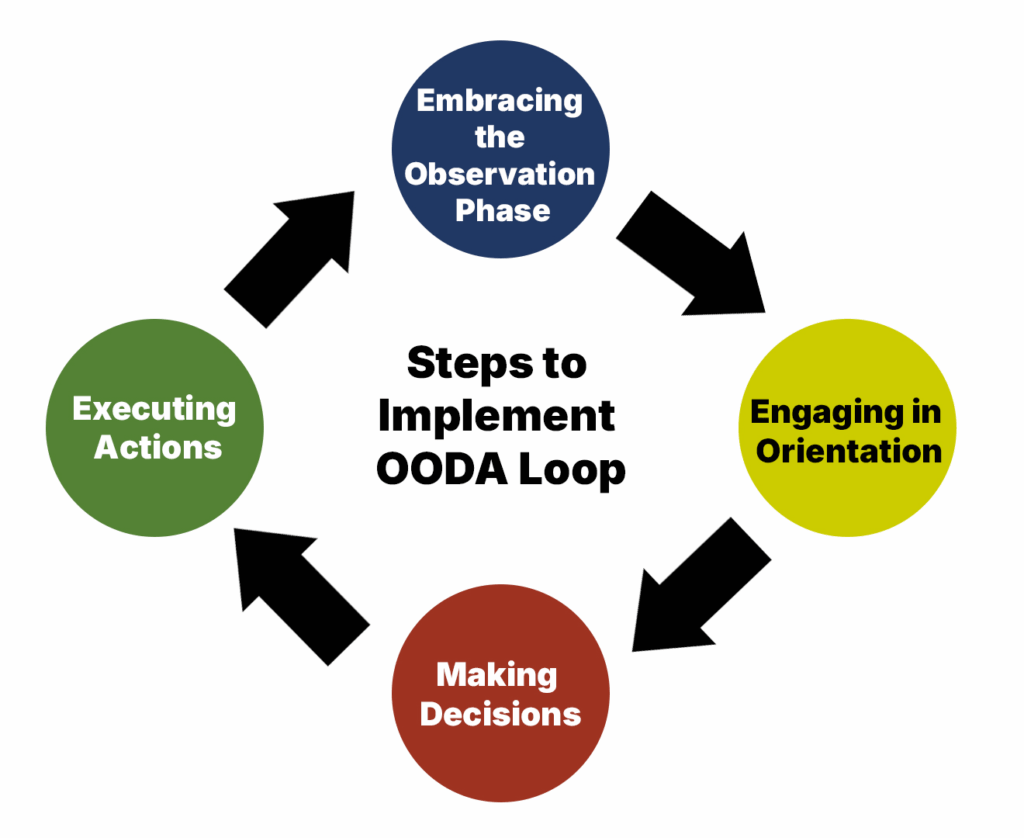
Embracing the Observation Phase
- Proactively gather insights from a variety of sources, such as industry reports, emerging market trends, and competitor behavior.
- Develop a keen sense of observation by consistently scanning your environment for meaningful signals and unexpected shifts.
- Leverage technology and data analytics to enhance your ability to collect and interpret information, ensuring a well-rounded perspective.
Engaging in Orientation
- Analyze the gathered information through the lens of your existing knowledge and experience.
- Identify key patterns, emerging trends, and their possible implications to build a deeper understanding of the current landscape.
- Promote collaborative thinking by incorporating insights from team members and external experts to enrich your orientation process.
Making Decisions
- Synthesize the insights from observation and orientation to craft informed, strategic plans.
- Adopt a mindset open to calculated risks, understanding that decision-making is an evolving process requiring flexibility and responsiveness.
- Strike a balance between timely action and thoughtful analysis, ensuring decisions are both prompt and well-grounded.
Executing Actions
- Put plans into motion with clear, deliberate execution.
- Track outcomes closely, setting the stage for continuous observation and iteration within the OODA Loop framework.
- Encourage a culture of adaptive execution, where individuals take ownership and remain agile in response to real-time developments.
Case Study and Applications of the OODA Loop
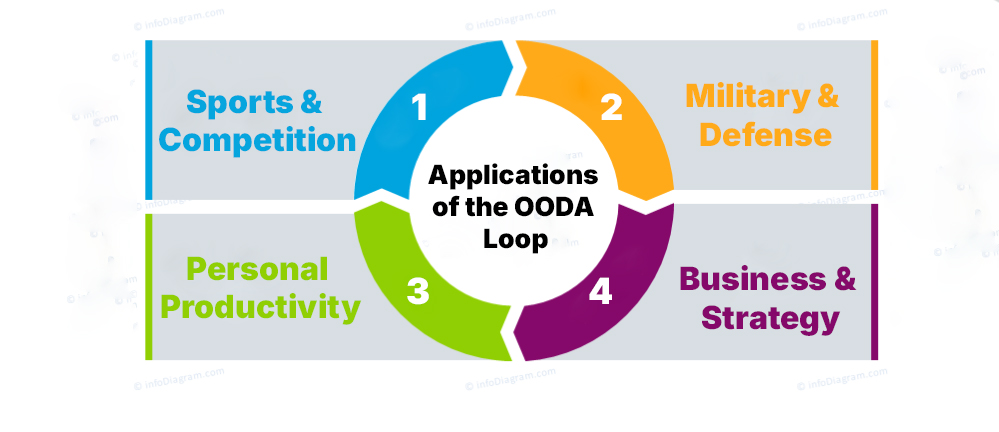
The OODA Loop’s versatility has made it a valuable decision-making framework not only in its original military context but across a wide range of fields.
Military & Defense
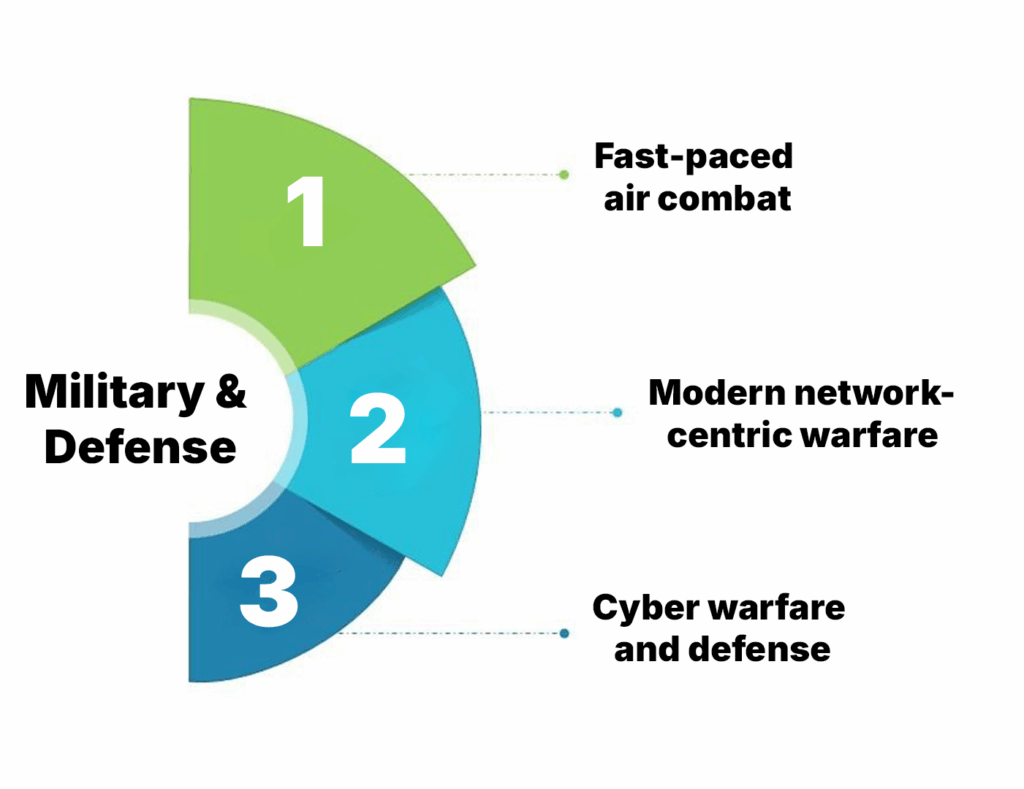
- Fast-paced air combat: During the Vietnam War, U.S. pilots rapidly cycled through the OODA Loop to outpace opponents, disrupting their responses and forcing mistakes.
- Modern network-centric warfare: Militaries use real-time sensors, data fusion, and AI to speed up the Observe and Orient phases.
- Cyber warfare and defense: In cyber operations, OODA helps identify threats (Observe), assess risks (Orient), decide on countermeasures (Decide), and deploy defenses (Act) in real time.
Business & Strategy
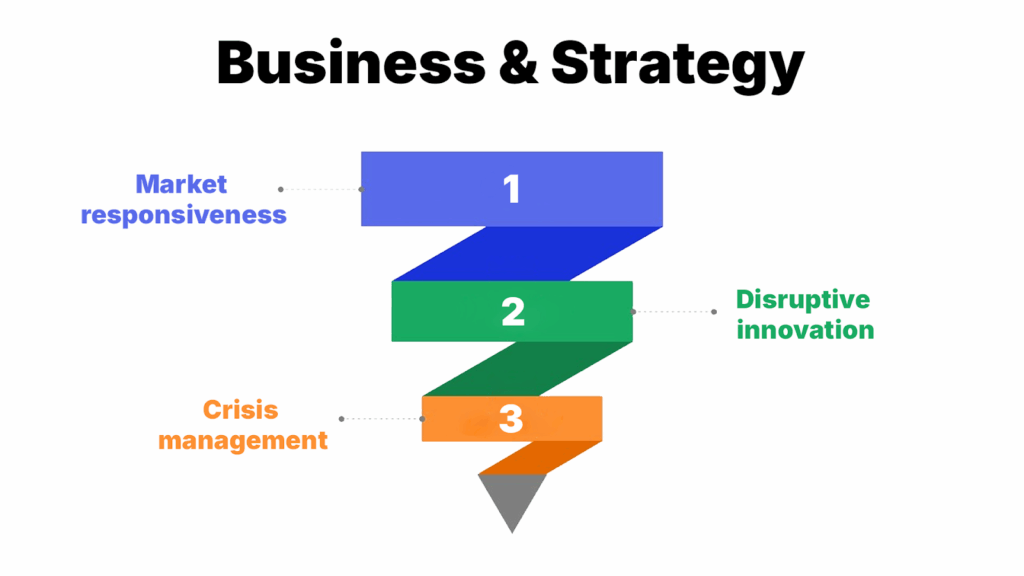
- Market responsiveness: Companies scan trends (Observe), analyze customer and competitor moves (Orient), decide on pivots (Decide), and execute campaigns (Act) to stay ahead.
- Disruptive innovation: Startups use rapid prototyping (Observe & Decide), iterative feedback (Orient), and fast deployment (Act) to disrupt industries.
- Crisis management: In a crisis, companies observe the situation, orient by analyzing factors, decide on a response, and act quickly to mitigate damage.
Sports & Competition
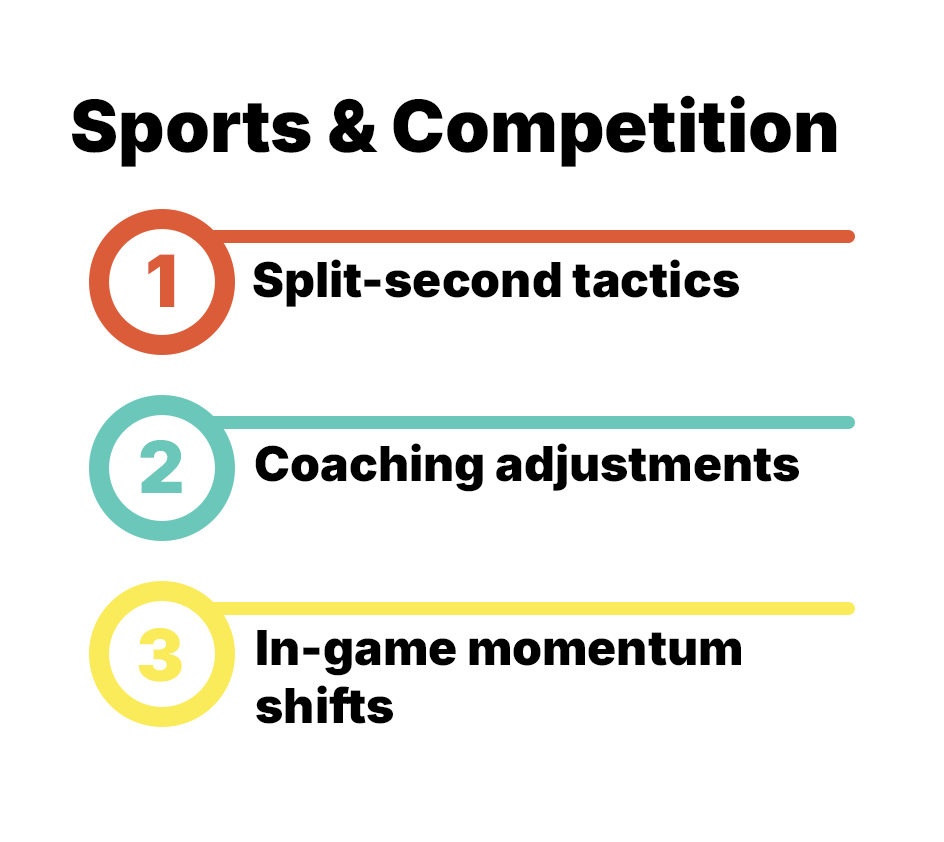
- Split-second tactics: Athletes observe opponents, orient based on training, decide in fractions of a second, and act with precision.
- Coaching adjustments: Coaches analyze stats and trends (Observe), decide on strategies (Decide), and make real-time changes (Act) to stay ahead.
- In-game momentum shifts: Teams adjust by observing weaknesses, orienting based on conditions, deciding on counter-strategies, and executing key plays.
Bruce Lee identified two traditional methods by which a fighter could use their cadence to accomplish this setup, the first being to adopt slower than normal actions in the lead up to a decisive attack.
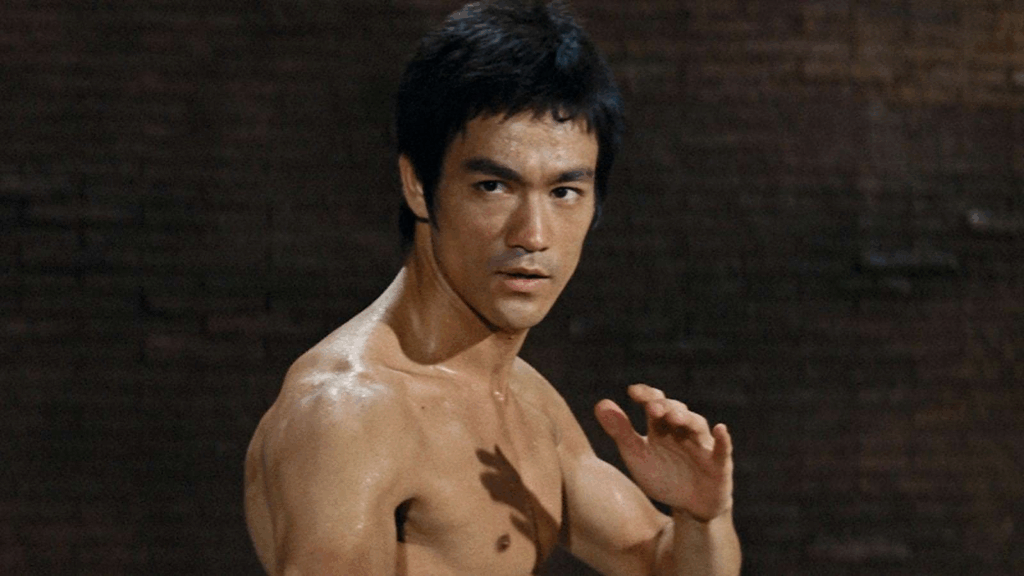
- In this application, after an opponent has adapted to our cadence, they are vulnerable to sudden accelerations in our actions.
- Alternatively, the lead up could be at a normal or quicker than normal speed, setting up a final attack at a slower cadence.
- This strategy effectively forces the adversary to commit to an action, allowing a combatant to watch the reaction and strike once the adversary is out of position. Bruce Lee labeled these methods as “striking on the half-beat.
Tempo, Speed, and Timing

- Two Key Elements: Speed and Timing: Tempo is shaped by how fast actions are taken (speed) and when they are taken (timing), both of which influence operational effectiveness.
- Strategic Synchronization with the Opponent: Effective combatants align their movements with their opponent’s actions to exploit psychological and physical vulnerabilities at exactly the right moment.
- Complexity Through Repetition and Variation: Boxing drills can include additional punches (threes, fours, fives, sixes) to create more complex rhythms, where each strike represents a beat in the sequence.
Personal Productivity
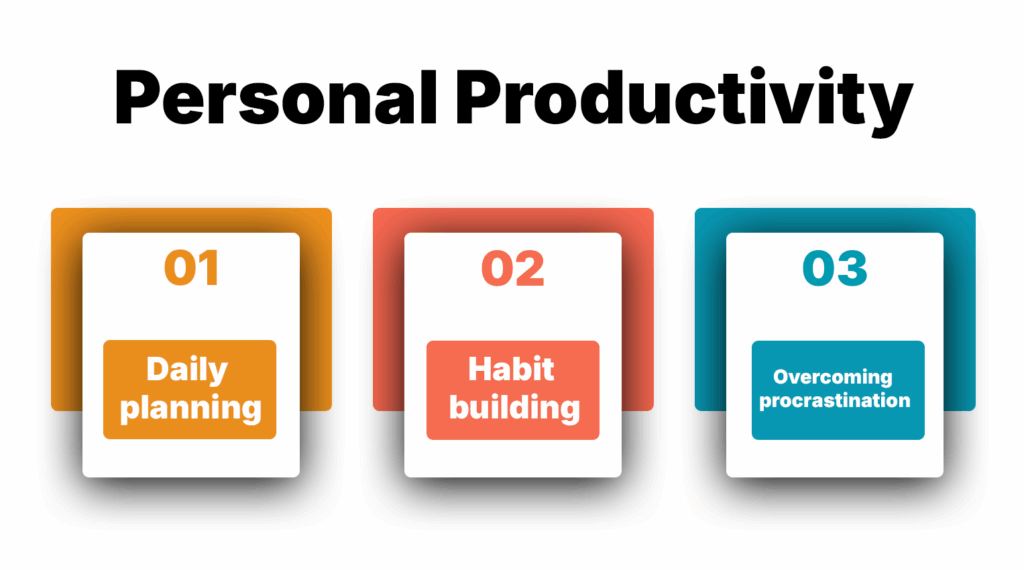
- Daily planning: Apply OODA to manage time: observe tasks (Observe), evaluate priorities (Orient), decide on a schedule (Decide), and act on key tasks (Act).
- Habit building: To form a habit, observe cues (time, location), orient with intention (Orient), decide on action (Decide), and act immediately (Act).
- Overcoming procrastination: Observe distractions, orient by identifying triggers, decide on an approach, and act by taking small steps to start.
Conclusion
In conclusion, the OODA Loop offers a robust and adaptable framework for navigating uncertainty and fast-paced change. By breaking down decision-making into four iterative phases—Observe, Orient, Decide, and Act—it enables individuals and organizations to remain agile, responsive, and strategically effective.
Whether in the high-stakes realm of military operations, the competitive landscape of business, or the complexities of everyday personal choices, the OODA Loop encourages continuous learning, situational awareness, and decisive action. Its core principles of adaptability, speed, and informed response make it an enduring tool for success across diverse domains.
Deepak Wadhwani has over 20 years experience in software/wireless technologies. He has worked with Fortune 500 companies including Intuit, ESRI, Qualcomm, Sprint, Verizon, Vodafone, Nortel, Microsoft and Oracle in over 60 countries. Deepak has worked on Internet marketing projects in San Diego, Los Angeles, Orange Country, Denver, Nashville, Kansas City, New York, San Francisco and Huntsville. Deepak has been a founder of technology Startups for one of the first Cityguides, yellow pages online and web based enterprise solutions. He is an internet marketing and technology expert & co-founder for a San Diego Internet marketing company.



